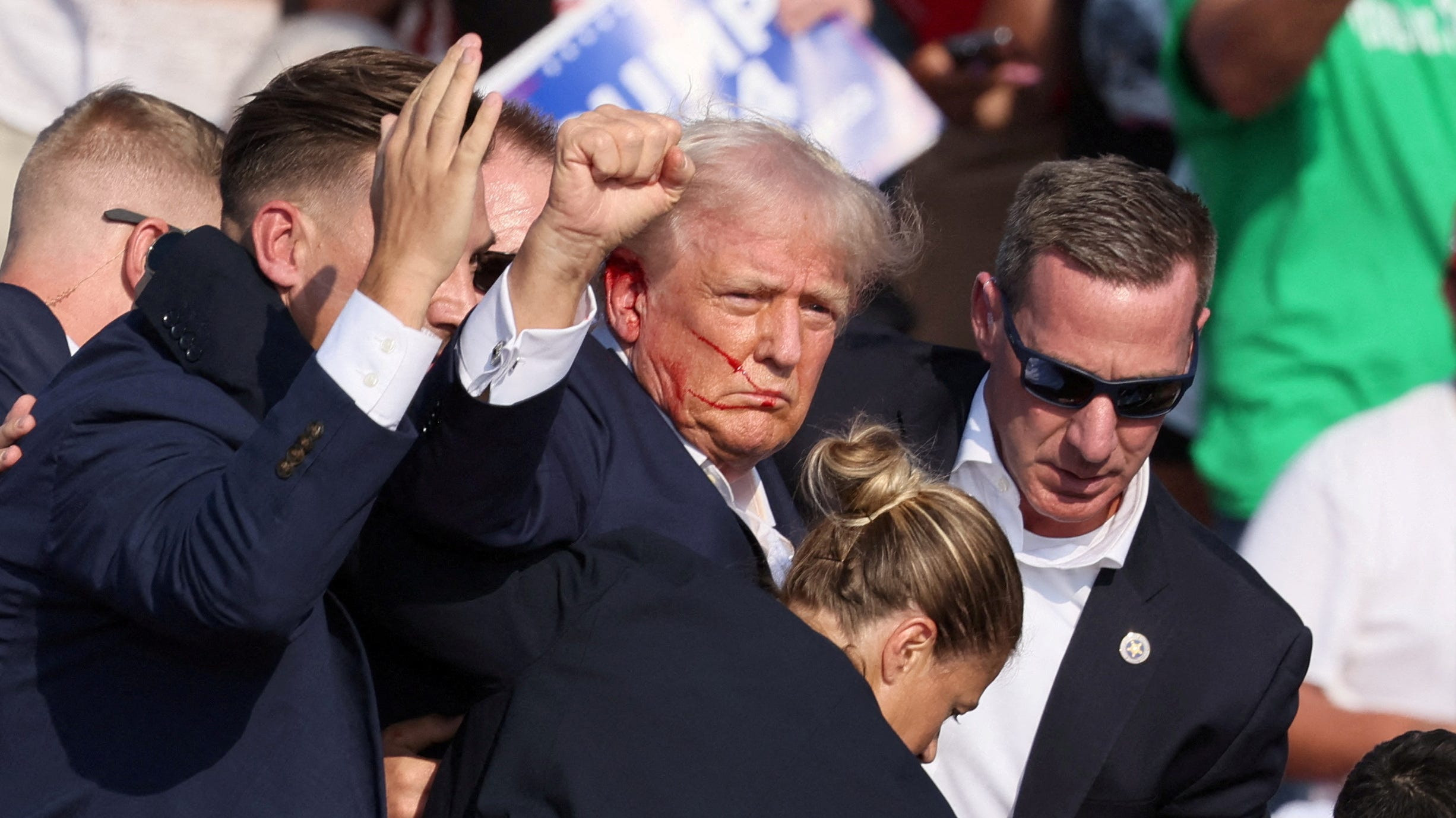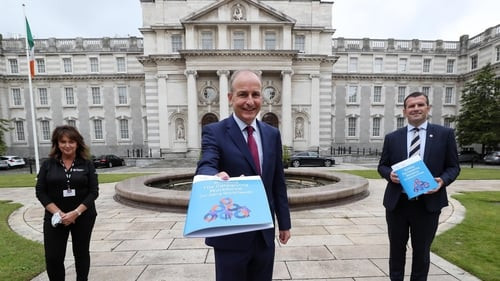Adams Township Police Department Sgt. Edward Lenz's testimony came Thursday morning during a hearing before the House Trump Assassination Attempt Task Force, which has been tasked with investigating the July 13 shooting of former President Trump, the first of two recent assassination attempts against him.
"Across the two counter assault teams, the quick reaction force, three sniper teams and support personnel, we provided total manpower of 44 persons, exceeding the number requested by the Secret Service," Lenz, a commander with the Butler County Emergency Services Unit (ESU), said in his opening remarks. "At no point during the planning process was Butler County ESU asked to secure the AGR complex, nor the perimeter surrounding that area. At no point during the planning process was Butler ESU asked to deploy a sniper team to the roof of the AGR complex."
Butler County snipers inside the AGR building could not see the shooter from the roof of the AGR complex, nor was that part of their duties for the day, Lenz added.
The Secret Service’s Failures
And the confusion is almost as bad as the massive foul-ups that allowed shooter Thomas Crooks to get off eight rounds, nearly killing the ex-prez.
In an interim report last week, a Senate committee probing the disaster listed multiple Secret Service failures that allowed the shooter to nearly assassinate Trump, kill another man and badly injure two more:
A member of the quick response force, however, noticed several suspicious people in the area, one of whom turned out to be the shooter.
The larger mystery is how such poor planning and so many botches could have happened.
Indeed, the incompetence — from beginning to end — is staggering, even for the bungle-prone Harris-Biden folks.
The list of why’s is endless, yet answers have been elusive — and contradictory.
That soon morphed into someone deciding it wasn’t necessary.
What gives?
Meanwhile, information has dribbled out slowly since the shooting, adding to the public’s confusion with every new fact.
Last week, Americans discovered that counter snipers wouldn’t have been assigned to the event at all, except for the word of that “credible evidence.” That contradicts claims that added personnel weren’t provided because Trump doesn’t hold high office and wasn’t yet the official GOP nominee.
OK: No one wants to take the rap for such monumental failures, so all finger-pointing, evasions, contradictions and collective blame-shifting comes as no surprise.
Fine. Congress should get to the bottom of this story, then every bungler should be fired.
Yes, USSS Director Kimberly Cheatle has already been forced out, after her own bit of stonewalling.
But the guy in the White House who hired Cheatle shares culpability, too.
The Secret Service is just one more thing Team Harris-Biden has screwed up — disastrously.
Local Police: ‘Thrown Under The Bus’
A Beaver County sniper took a photo of the suspicious male near the AGR building and a photo of the shooter using a range finder pointing toward the stage, who was later identified as Crooks.
The sniper reported that information to the Pennsylvania State Police, Lenz explained. The FBI previously said this sighting occurred around 5:10 p.m. on July 13, one hour and one minute before Crooks began shooting.
Soon afterward, when it became clear that a threat was on the roof of the AGR building, an operator with Butler County ESU exited the red barn from behind the stage where Trump was speaking and monitored the AGR building area, Lenz said. He "quickly identified" where the shots were coming from, located the shooter, and fired one round at Crooks with his rifle, "which caused the shooter to recoil and briefly fall out of sight," the Adams Township officer testified.
"He did this less than six seconds after shots began… at a distance of approximately 110 yards," Lenz said.
A Secret Service counter sniper then fired the fatal shot that neutralized Crooks on the roof of the AGR building, where he was perched with a direct line of sight to Trump.
The FBI previously told reporters during a press call that the Secret Service counter sniper fired the fatal round that killed Crooks approximately 15.5 seconds after Crooks began shooting. The FBI also noted at that time that the local officer who fired a round at Crooks did not hit him.
"Regarding the round fired by the local officer, we have no forensic evidence indicating that that round either struck our subject or the subject's rifle," FBI Pittsburgh Special Agent in Charge Kevin Rojek said in August.
Communication Breakdown
During Thursday’s hearing, local officers testified to the convoluted communication set up that day, where multiple different groups of officers were on different radios, all separate from the Secret Service’s own channel.
But those findings were overshadowed by a second panel consisting of two GOP representatives who put forward blatant conspiracy theories around the shooting.
Democrats on the task force did not attend the second part of the hearing, which included testimony from Reps. Eli Crane of Arizona and Cory Mills of Florida.
Rep. Jason Crow of Colorado, the task force’s top Democrat, told reporters that members of his party left because they were not informed that Crane and Mills would be joining the hearing until Wednesday.
“We did not receive notice of this panel until late yesterday,” Crow said, adding that they didn’t have time to add their own experts to the panel or know what those members were going to say.
Crow added that he hoped the task force could “return to the consensus-based approach going forward” with Republicans at the task force. “We don’t see a reason to participate in this panel for the reasons I described,” Crow said.
“Panel one was a very productive panel,” Crow added when asked about the second part of the hearing, which included Mills and Crane.
The chairman of the committee, GOP Rep. Mike Kelly of Pennsylvania, told reporters that the presentation from Mills and Crane doesn’t change the bipartisan spirit of the panel and shared that he invited the lawmakers because of their combat experience.
“It’s not going to shatter my feeling that it’s bipartisan. If somebody has another opinion, that’s their opinion,” Kelly said.
Asked whether the work of Crane and Mills undermines his task force, Kelly added, “You know at this point in my life, I’m not that fragile. We were tasked to get to an answer. If we have assets out there that we’re ignoring because we think somehow that’s overstepping our chance to be in the spotlight that day, then you should go home. I’m not here as a Republican. I’m here as an American”
The appearance of Crane and Mills at Thursday’s hearing, where they urged Republican task force members to investigate all conspiracy theories related to the July 13 assassination attempt – including the idea of a second shooter, which has been flatly denied by federal investigators – represents a public blending of the two investigative efforts at a time when Trump has increasingly blamed Democrats for the threats against him while on the campaign trail.
Kelly said, “I think that’s something we are going to seriously consider” when asked if his task force would investigate the prospect of there being a second shooter.
Some Republican members of the task force defended the decision to allow Crane and Mills to speak at the hearing despite the fact that their appearance seemed to undermine the task force’s authority as the House’s primary investigative body when it comes to probing the first Trump assassination attempt.
“We must investigate every potential theory,” said GOP Rep. Clay Higgins, who used his time earlier in the hearing to press the medical examiner on whether gunman Thomas Crooks could have been shot twice, in the same bullet wound hole, adding he doesn’t believe in the concept of conspiracy theories.
Task Force Faces Division
By removing themselves from the hearing room, Democrats clearly signaled they viewed the appearance by Crane and Mills as partisan – marking the first public sign of discontent within the task force, which has pledged to remain apolitical, to date.
While House Speaker Mike Johnson and Democratic leader Hakeem Jeffries have called for members to put politics aside on the investigation, Crane, Mills and other ardent Trump allies on Capitol Hill continued to publicize their own supposed findings and lambast federal officials for over the security failures at Trump’s Butler rally – calling for quick and strong accountability.
When members of the bipartisan task force visited the Butler rally site in August, the group of conservative congressmen held a counterprogramming event on their separate efforts to investigate the assassination attempt, despite not having any significant investigative power and not being affiliated with the task force.
The Task Force on Thursday heard testimony from three local Pennsylvania law enforcement officials, including Lenz, who provided security protection at the July 13 rally; the medical examiner who conducted Crooks' autopsy; and a retired Secret Service agent.
Trump Campaign Must Be Investigated
The Secret Service, despite initially blaming local law enforcement for the catastrophe in Butler, has repeatedly said the agency is fully to blame for the failures that day. Questions remain, however, why local officers were not able to stop Crooks from climbing on top of a group of nearby buildings with a rifle, despite prior warnings about Crooks both on the ground and on the rooftop minutes before he began firing. Crooks was killed by Secret Service agents at the scene moments after the shooting.
Crow added that the Trump campaign, and its coordination with Secret Service and local law enforcement is also an element the task force will have to investigate to better understand where communication breakdowns occurred. The panel has already requested the interviews Trump campaign officials did with federal law enforcement agencies in the wake of the first assassination attempt.
“We think that’s a critical piece of the puzzle here that we have to look at,” Crow said Thursday.
Witnesses largely suggested that the Secret Service's lack of direction given to local agencies ultimately led to the security failures that allowed 20-year-old Crooks to position himself on a nearby rooftop and fire at the former president, striking him in the ear and killing rally attendee Corey Comperatore. Two other attendees, David Dutch and James Copenhaver, were critically wounded by Crooks' gunfire.
“If we knew there was a suspicious person out there… why in the world would you let President Trump go on that platform?” Task Force Chairman Rep. Mike Kelly, R-Penn., asked during his opening remarks.
Secret Service’s Shortcomings Highlighted
During the first part of the hearing, local officers testified to the communication issues, where multiple different groups of officers were on different radios, all separate from the Secret Service’s own channel.
The hearing came the day after a bipartisan committee in the Senate released a damning report highlighting key failures by the Secret Service that day, including the lack of decision-making and leadership structure.
Those failures, the report said, led to significant lapses in security measures, including a denial of resources and lack of decision-making around who was responsible for what area of the rally, including the cluster of buildings the shooter climbed.
The first part of the House task force hearing, instead, focused on local law enforcement and their actions around that day, marking the conclusion of the first phase of the task force’s investigation. Witnesses include a local police patrolman and sergeant as well as a Pennsylvania State Police officer and medical examiner.
In the minutes before Crooks opened fire on Trump, reports of a man on the roof went out to different channels, all set up to go through two different communication posts, according to testimony Thursday. Those calls never made it to the Secret Service agents on Trump’s detail.
Members also highlighted how cell systems established in the wake of the September 11, 2001, terrorist attacks were operating well while normal cell phone connection was spotty and became an issue for local officers as they tried to share early pictures of Crooks.
Those systems, such as FirstNet – built for emergency responders to communicate with each other in moments of crisis – worked that day, Edward Lenz, the commander of the Butler County Emergency Services Unit, told the task force.
“They worked the entire time,” Lenz said.
Democratic Rep. Jared Moskowitz of Florida noted that 45 minutes before the shooting, some officers were unable to receive photos taken of Crooks that day, while others, who were on FirstNet, could.
“We created a solution, and yet it’s 2024, and we’re still not implementing that solution at the highest levels of our security agencies” to keep Trump safe, Moskowitz said.
Local officers also testified to the lack of meetings with Secret Service and no direction on certain areas of coverage, including the buildings Crooks climbed.
The task force, which was recently expanded by the House to include in its investigation the second attempted assassination of Trump in Florida this month, has previously visited the rally site in Pennsylvania and has met with and interviewed local and federal officers involved in the security and subsequent investigations into that day.
‘It’s Not A Single Mistake’
There was no plan to secure the building where the gunman was positioned with a clear line of sight to the location where Trump would speak, the officials told the first meeting of a congressional task force investigating the shooting. Secret Service officials allowed Trump to take the stage even as local police were flagging concerns about a suspicious person.
“It was not a single mistake that allowed (Thomas Matthew) Crooks to out-maneuver one of our country's most elite group of security professionals,” said task force chairman Mike Kelly, R-Pa. Instead, the Secret Service failed to make a cohesive plan for the law enforcement partners, didn't close down the grounds near the rally site, and didn't communicate effectively even in moments of crisis, he said.
“Altogether, these other failures led to a dysfunctional security situation that took the life of Mr. Comperatore, injured two others, and nearly claimed the former president's life.”
The hearing comes the day after a Senate committee released its investigative report into the July assassination attempt. Those findings, from the Homeland Security and Governmental Affairs Committee, also said the Secret Service had no plan to secure the building where Crooks took aim. It also showed there was no clear chain of command and other security lapses at the event.
The congressional hearing also comes after a second likely assassination attempt against the former president earlier this month at his golf club in Florida. The House's task force has expanded its investigation to also look at security lapses related to that attempt.
‘The Secret Service Must Do Better’
Acting Secret Service Director Ronald Rowe said in a statement Thursday, “We thank Congress for addressing some of the U.S. Secret Service’s most immediate needs in this heightened threat environment. This short-term funding will better equip the U.S. Secret Service to enhance security measures in the months ahead. We look forward to working with Congress on full-year funding to deliver the additional personnel, technology, and equipment our workforce needs to do their jobs.”
On the day of the rally, Crooks parked his vehicle and flew a drone between approximately 3:50 p.m. and 4 p.m. about 200 yards from where the former president would be speaking. FBI Director Christopher Wray testified during a July 17 congressional hearing that Crooks had been at the rally site for about 70 minutes the morning of the assassination attempt.
Investigators located eight casings on the roof where Crooks fired from.
This story and headline have been updated with additional developments.
© 2024 Cable News Network. A Warner Bros. Discovery Company. All Rights Reserved. CNN Sans ™ & © 2016 Cable News Network.

















